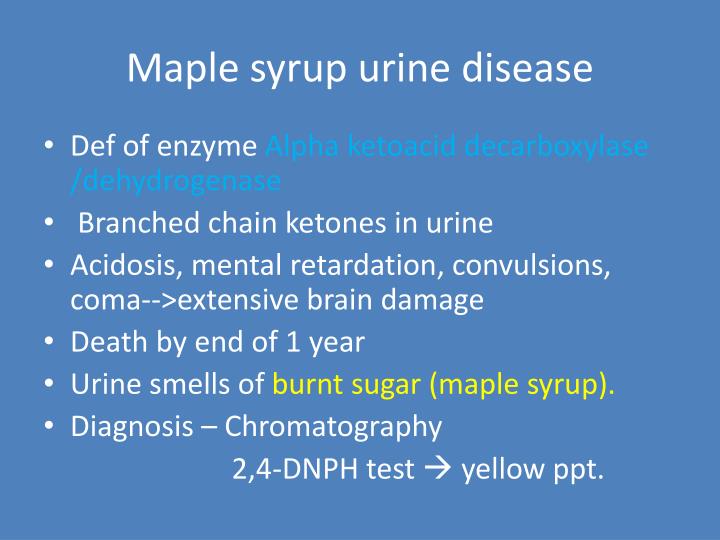

Mutations in the following genes cause maple syrup urine disease:

Maple syrup urine disease has an autosomal recessive pattern of inheritance. Additionally, MSUD patients experience an abnormal course of diseases in simple infections that can lead to permanent damage. Death from cerebral edema will likely occur if there is no treatment. Untreated in older individuals, and during times of metabolic crisis, symptoms of the condition include uncharacteristically inappropriate, extreme or erratic behavior and moods, hallucinations, lack of appetite, weight loss, anemia, diarrhea, vomiting, dehydration, lethargy, oscillating hypertonia and hypotonia, ataxia, seizures, hypoglycaemia, ketoacidosis, opisthotonus, pancreatitis, rapid neurological decline, and coma. The symptoms of MSUD may also present later depending on the severity of the disease. Symptoms associated with thiamine-response MSUD are similar to intermediate MSUD. Metabolic crisis leading to seizures, coma, and brain damage is still a possibility. Symptoms of lethargy and characterized odor of maple syrup will occur when the individual experiences stress, does not eat, or develops an infection.

Intermittent MSUD Ĭontrary to classic and intermediate MSUD, intermittent MSUD individuals will have normal growth and intellectual development. Symptoms associated with classic MSUD also appear in intermediate MSUD. The majority of children with intermediate MSUD are diagnosed between the ages of 5 months and 7 years. Intermediate MSUD has greater levels of residual enzyme activity than classic MSUD. Additional signs and symptoms that can be associated with classic MSUD include intellectual limitation and behavioral issues. Although MSUD can be stabilized, there are still threats of metabolic decompensation and loss of bone mass that can lead to osteoporosis, pancreatitis, and intracranial hypertension. If MSUD is left untreated, central neurologic function and respiratory failure will occur and lead to death. These neurologic signs include athetoid, hypertonia, spasticity, and opisthotonus that lead to convulsions and coma. The infant will then experience increased focal neurologic signs. Subtle symptoms include poor feeding, either bottle or breast, lethargy, and irritability. Infants with classic MSUD will display subtle symptoms within the first 24–48 hours. Symptoms of MSUD varies between patients and is greatly related to the amount of residual enzyme activity. In populations to whom maple syrup is unfamiliar, the aroma can be likened to fenugreek, and fenugreek ingestion may impart the aroma to urine. The smell is also detected in ear wax of an affected individual during metabolic crisis. The disease is named for the presence of sweet-smelling urine, similar to maple syrup, when the person goes into metabolic crisis. The condition gets its name from the distinctive sweet odor of affected infants' urine and earwax, particularly prior to diagnosis and during times of acute illness. Maple syrup urine disease ( MSUD) is an autosomal recessive metabolic disorder affecting branched-chain amino acids. Leucine (pictured above), Isoleucine, and valine are the branched-chain amino acids that build up in MSUD. This results show the need for increase awareness of metabolic disorder such as MSUD and the requirement for early detection and treatment to ensure a better outcome.Medical condition Maple syrup urine disease All patients had neurological sequelae and psychomotor retardation. Majority of cases were initially diagnosed as sepsis and/or meningitis. Clinical manifestations were non-specific such as poor suck, weak cry, drowsiness and seizures. The diagnosis was accomplished by clinical diagnosis and confirmed by detecting abnormal levels of amino acids in the blood and organic acids in the urine. The time taken to make the diagnosis ranged from 18 to 356 days (median 55 days).

The onset of symptoms ranged from 3 to 20 days (median 8 days). All cases presented in the neonatal period. Thirteen cases of classic MSUD were diagnosed from 1997-2007 at the Queen Sirikit National Institute of Child Health. Classic MSUD usually manifests in the neonatal period with poor feeding, vomiting, lethargy, muscular hypertonicity, seizure, coma and death. Maple syrup urine disease (MSUD) is a rare inborn error of metabolism, caused by a deficiency in activity of the branched chain alpha-keto acid dehydrogenase impairing the degradation of the branched-chain amino acids (leucine, isoleucine and valine).


 0 kommentar(er)
0 kommentar(er)
